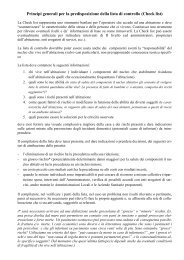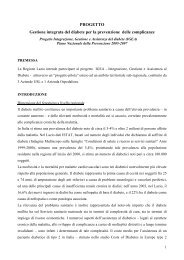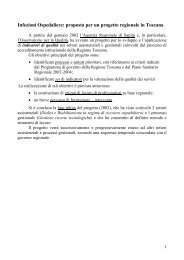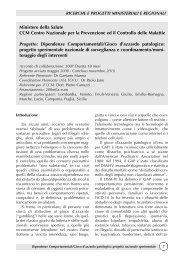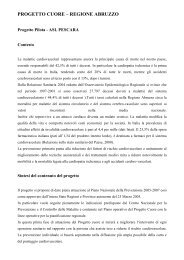Gaining health : analysis of policy development in European ...
Gaining health : analysis of policy development in European ...
Gaining health : analysis of policy development in European ...
Create successful ePaper yourself
Turn your PDF publications into a flip-book with our unique Google optimized e-Paper software.
Chapter 3<br />
16<br />
determ<strong>in</strong>e <strong>policy</strong> outcomes, but a highly political process <strong>in</strong><br />
which power and <strong>in</strong>terest are the ma<strong>in</strong> driv<strong>in</strong>g forces”.<br />
Partly because <strong>of</strong> the non-l<strong>in</strong>earity <strong>of</strong> real life, and <strong>of</strong> issues<br />
that cut across all stages <strong>of</strong> the process, some <strong>of</strong> the stages<br />
<strong>of</strong> the <strong>policy</strong> cycle were merged so as to avoid repetition<br />
when present<strong>in</strong>g the f<strong>in</strong>d<strong>in</strong>gs <strong>of</strong> the case studies.<br />
Types <strong>of</strong> <strong>policy</strong> for tackl<strong>in</strong>g NCD<br />
The <strong>European</strong> NCD Strategy (1) def<strong>in</strong>es NCD as:<br />
a group <strong>of</strong> conditions that <strong>in</strong>cludes cardiovascular disease,<br />
cancer, mental <strong>health</strong> problems, diabetes mellitus, chronic<br />
respiratory disease and musculoskeletal conditions. This<br />
broad group is l<strong>in</strong>ked by common risk factors, underly<strong>in</strong>g<br />
determ<strong>in</strong>ants and opportunities for <strong>in</strong>tervention.<br />
The focus <strong>of</strong> the <strong>European</strong> NCD Strategy, and consequently<br />
<strong>of</strong> the case studies, was therefore on how countries tackle<br />
these diseases, exclud<strong>in</strong>g other noncommunicable conditions<br />
such as accidents.<br />
The results <strong>of</strong> the WHO survey (2) <strong>in</strong>dicated that <strong>European</strong><br />
countries tackle NCD through a wide range <strong>of</strong> policies,<br />
implemented at different levels <strong>of</strong> authority and <strong>in</strong> different<br />
sett<strong>in</strong>gs. These <strong>in</strong>clude:<br />
• broad or “umbrella” <strong>health</strong> policies<br />
• public <strong>health</strong> and <strong>health</strong> promotion policies<br />
• <strong>health</strong> services policies<br />
• issue-specific policies (deal<strong>in</strong>g with specific diseases or<br />
<strong>health</strong> risks)<br />
• levels and sett<strong>in</strong>gs <strong>of</strong> <strong>policy</strong> <strong>development</strong><br />
• general policies with a <strong>health</strong> component.<br />
It was clear, therefore, that the case studies would need to<br />
exam<strong>in</strong>e this wide range <strong>of</strong> policies. To ensure a common<br />
understand<strong>in</strong>g <strong>of</strong> terms used and the different types <strong>of</strong><br />
<strong>policy</strong> <strong>of</strong> concern, these are briefly described below. Broad<br />
or “umbrella”-type policies could be found under different<br />
head<strong>in</strong>gs <strong>in</strong> different countries, <strong>in</strong>clud<strong>in</strong>g policies for <strong>health</strong><br />
for all, public <strong>health</strong>, <strong>health</strong> promotion, <strong>health</strong> systems<br />
or <strong>health</strong> care. They were variously labelled as policies,<br />
programmes, plans, strategies or resolutions, accord<strong>in</strong>g to<br />
the usual usage <strong>in</strong> the country (and the translation from the<br />
orig<strong>in</strong>al language version). These “categories” are frequently<br />
overlapp<strong>in</strong>g or blurred. “Umbrella”-type policies may be<br />
formulated at national, regional or city levels.<br />
S<strong>in</strong>ce the adoption <strong>in</strong> the mid-1980s <strong>of</strong> the WHO <strong>European</strong><br />
Health for All targets (8), many countries have developed<br />
their own Health for All policies at national, regional and/or<br />
city levels. A Health for All <strong>policy</strong> is def<strong>in</strong>ed as one “based<br />
on pr<strong>in</strong>ciples <strong>of</strong> equity and democratic participation <strong>in</strong> decision-mak<strong>in</strong>g.<br />
It deals with issues <strong>of</strong> lifestyles, environment<br />
and <strong>health</strong> care” (9). Thus a Health for All <strong>policy</strong> is perhaps<br />
the broadest type <strong>of</strong> <strong>health</strong> <strong>policy</strong> and, most importantly, is<br />
based on explicit values or, as expressed <strong>in</strong> the 2005 update<br />
<strong>of</strong> the WHO <strong>European</strong> Health for All <strong>policy</strong> (10), is “valuesbased,<br />
values-driven”.<br />
In the context <strong>of</strong> the 2005 update, 52 national <strong>health</strong> policies<br />
were analysed accord<strong>in</strong>g to four criteria (10):<br />
• the <strong>policy</strong> commits itself to the goal <strong>of</strong> Health for All <strong>in</strong><br />
a document;<br />
• it <strong>in</strong>troduces a multisectoral perspective;<br />
• it is explicitly values-oriented; and<br />
• it <strong>in</strong>cludes <strong>health</strong> targets.<br />
Forty policies satisfied all four criteria.<br />
It can be difficult to dist<strong>in</strong>guish between “public <strong>health</strong>” and<br />
“<strong>health</strong> promotion” policies, and <strong>in</strong> practice it is frequently a<br />
question <strong>of</strong> labell<strong>in</strong>g <strong>in</strong> a particular country. Over the years,<br />
the focus <strong>of</strong> public <strong>health</strong> has expanded from what might<br />
be called issues <strong>of</strong> “hygiene” (ma<strong>in</strong>ly provid<strong>in</strong>g clean water,<br />
sewage disposal and protection from communicable diseas-<br />
Methodology, underly<strong>in</strong>g concepts and values



